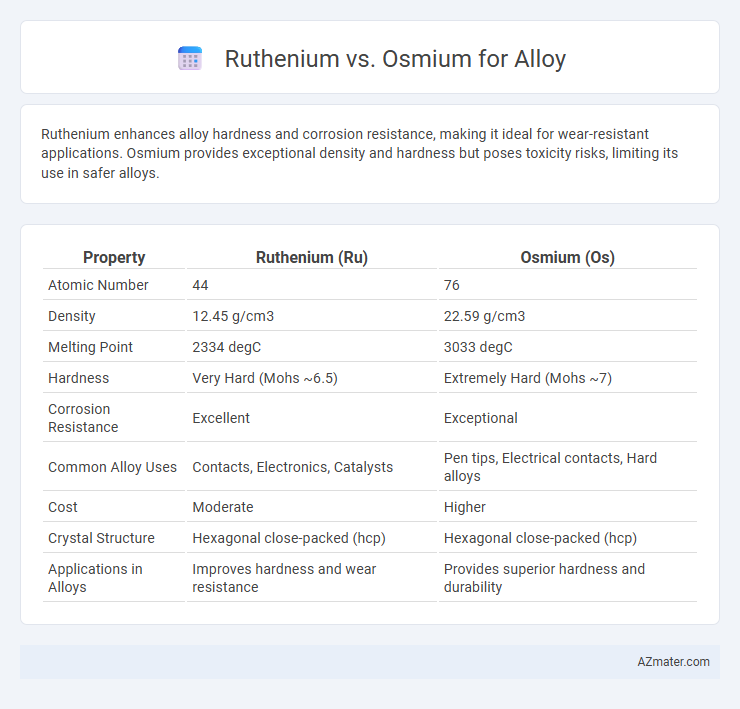Ruthenium enhances alloy hardness and corrosion resistance, making it ideal for wear-resistant applications. Osmium provides exceptional density and hardness but poses toxicity risks, limiting its use in safer alloys.
Table of Comparison
| Property | Ruthenium (Ru) | Osmium (Os) |
|---|---|---|
| Atomic Number | 44 | 76 |
| Density | 12.45 g/cm3 | 22.59 g/cm3 |
| Melting Point | 2334 degC | 3033 degC |
| Hardness | Very Hard (Mohs ~6.5) | Extremely Hard (Mohs ~7) |
| Corrosion Resistance | Excellent | Exceptional |
| Common Alloy Uses | Contacts, Electronics, Catalysts | Pen tips, Electrical contacts, Hard alloys |
| Cost | Moderate | Higher |
| Crystal Structure | Hexagonal close-packed (hcp) | Hexagonal close-packed (hcp) |
| Applications in Alloys | Improves hardness and wear resistance | Provides superior hardness and durability |
Introduction to Ruthenium and Osmium
Ruthenium and Osmium are both rare transition metals in the platinum group, known for their exceptional hardness and corrosion resistance, making them valuable in high-performance alloys. Ruthenium enhances alloy strength and wear resistance due to its high melting point of 2,334 degC and excellent oxidation resistance. Osmium, with a melting point of 3,033 degC, is the densest naturally occurring element and contributes superior hardness and durability to alloys used in extreme environments.
Chemical and Physical Properties Comparison
Ruthenium and Osmium are both transition metals in the platinum group, widely used in high-performance alloys due to their exceptional hardness and corrosion resistance. Ruthenium exhibits a hexagonal close-packed structure with a melting point of 2334degC and excellent resistance to oxidation, whereas Osmium has one of the highest densities (22.59 g/cm3) and a melting point of 3045degC, making it incredibly durable but more brittle in alloys. Chemically, Ruthenium is more chemically inert and less prone to oxidation than Osmium, which forms volatile and toxic osmium tetroxide, influencing their respective applications in catalyst alloys and electrical contacts.
Availability and Cost Factors
Ruthenium and osmium exhibit distinct availability and cost profiles affecting their use in alloys; ruthenium is more abundant with annual production around 20 metric tons, while osmium is rarer and produced in smaller quantities. Ruthenium's price per ounce is generally lower, ranging between $150 to $300, compared to osmium, which can exceed $400 due to its scarcity and complex extraction processes. These availability and cost differences make ruthenium more favorable for industrial alloy applications where budget and supply stability are critical.
Alloying Behavior of Ruthenium
Ruthenium exhibits exceptional alloying behavior by enhancing hardness, corrosion resistance, and high-temperature stability when combined with metals like platinum and titanium. Its ability to improve tensile strength and wear resistance makes it a preferred additive in advanced superalloys and electrical contacts. Compared to osmium, ruthenium offers superior ductility and catalysis potential, making it invaluable for specialized alloy formulations in aerospace and electronics.
Alloying Behavior of Osmium
Osmium exhibits superior alloying behavior compared to ruthenium due to its higher melting point of 3045degC and greater density of 22.59 g/cm3, which enhance the mechanical strength and corrosion resistance of alloys. Its ability to form stable intermetallic compounds with platinum group metals makes it ideal for high-performance applications in electronics and catalysis. Ruthenium, while valuable for hardening alloys, lacks the extreme durability and thermal stability that osmium provides in demanding environments.
Mechanical Strength and Durability
Ruthenium and Osmium are both precious metals commonly used in high-performance alloys, with Osmium offering superior mechanical strength due to its exceptionally high density and hardness. Ruthenium enhances alloy durability by improving corrosion resistance and hardness without significantly increasing brittleness, making it ideal for wear-resistant applications. Osmium alloys provide greater longevity under extreme conditions, while Ruthenium-based alloys balance strength and flexibility for versatile industrial uses.
Corrosion and Wear Resistance
Ruthenium and osmium are both platinum-group metals known for their exceptional corrosion and wear resistance in alloys, with ruthenium offering superior resistance to oxidative environments and chemical attack. Osmium exhibits outstanding hardness and wear resistance but is more prone to forming osmium tetroxide, a toxic and volatile oxide that can affect corrosion performance. In alloy applications requiring long-term durability and minimal degradation, ruthenium alloys are preferable due to their enhanced oxidation stability and lower toxicity concerns.
Industrial Applications of Ruthenium Alloys
Ruthenium alloys are highly valued in industrial applications for enhancing corrosion resistance and mechanical strength in electrical contacts, chemical reactors, and turbine blades. Compared to osmium alloys, ruthenium provides superior stability in harsh environments, making it essential in electronics and aerospace industries. Its ability to improve wear resistance and conductivity while maintaining durability under extreme conditions drives widespread adoption in critical manufacturing processes.
Industrial Applications of Osmium Alloys
Osmium alloys exhibit exceptional hardness, high density, and excellent corrosion resistance, making them ideal for use in industrial applications such as electrical contacts, fountain pen tips, and instrument pivots. Unlike ruthenium, osmium alloys maintain superior durability under extreme mechanical stress and chemical exposure, enhancing performance in precision engineering and aerospace industries. The combination of osmium's mechanical strength and resistance to wear significantly extends the operational lifespan of components in high-load environments.
Choosing the Right Metal for Alloying Purposes
Ruthenium and osmium both offer exceptional hardness and corrosion resistance, making them popular choices for alloying in high-performance applications. Ruthenium enhances wear resistance and stabilizes the microstructure in platinum and palladium alloys, while osmium provides unparalleled density and hardness, ideal for extreme mechanical stress conditions. Selecting the right metal depends on whether the application prioritizes durability with low weight (ruthenium) or maximum hardness and density (osmium).

Infographic: Ruthenium vs Osmium for Alloy
 azmater.com
azmater.com